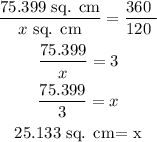The area of a circle is computed as follows:

If the radius is 7 cm, then the area is:

If the radius is 5 cm, then the area is:

Then, the area of the "ring" made by the subtraction of a circle of a radius of 5 cm to a circle of a radius of 7 cm is:
153.938 - 78.539 = 75.399 sq. cm
In the picture of the problem, we see a part of this "ring". The whole area computed before corresponds to an angle of 360°, to calculate the area that corresponds to 120° we can use the next proportion:

The perimeter of a circle is computed as follows:

If the radius is 7 cm, then the perimeter is:

Given that 120° is 1/3 of a circle, then the length of the top arc is:
1/3*43.982 = 14.66 cm
If the radius is 5 cm, then the perimeter is:

Given that 120° is 1/3 of a circle, then the length of the bottom arc is:
1/3*31.415 = 10.471 cm
Then, the perimeter of the figure is:
14.66 + 10.471 + 2 + 2 = 29.131 cm